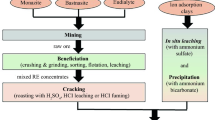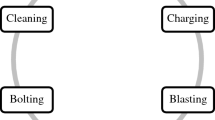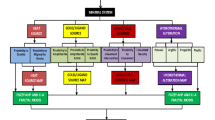Abstract
Mine planning is influenced by many sources of uncertainty. Significant sources of geological uncertainty in mine planning include uncertainty in layout of geological domains and uncertainty in metal grades. These two sources of uncertainty cannot be modeled separately because the distribution of the grade is controlled usually by geological domains. Two approaches exist for combining these two sources of uncertainty: the joint simulation approach and the cascade approach. In this paper, these two approaches were compared using a real case study. To this end, uncertainty in iron grade (quantitative variable) and ore zones (qualitative variable) was modeled using both approaches. There were some considerable differences in the results obtained by each approach, which confirm the importance of choosing the most appropriate approach with consideration of the dominate features of a deposit.















Similar content being viewed by others
References
Alabert, F. G., & Massonnat, G. J. (1990). Heterogeneity in a complex turbiditic reservoir: Stochastic modelling of facies and petrophysical variability. In SPE Annual technical conference and exhibition. Society of Petroleum Engineers. https://doi.org/10.2118/20604-MS
Alarcón, M., Emery, X., & Morales, N. (2015). Using simulation to assess the trade-off between value and reliability in open pit planning. In Application of computers and operations research in the mineral industry - proceedings of the 37th international symposium, APCOM 2015, (pp. 333–342).
Armstrong, M., Galli, A., Beucher, H., Loch, G., Renard, D., Doligez, B., et al. (2011). Plurigaussian simulations in geosciences. Springer. https://doi.org/10.1007/978-3-642-19607-2
Boucher, A., & Dimitrakopoulos, R. (2012). Multivariate block-support simulation of the yandi iron ore deposit Western Australia. Mathematical Geosciences, 44(4), 449–468.
Casella, G., & George, E. I. (1992). Explaining the Gibbs sampler. The American Statistician, 46, 167–174.
Chicoisne, R., Espinoza, D., Goycoolea, M., Moreno, E., & Rubio, E. (2012). A new algorithm for the open-pit mine production scheduling problem. Operations Research, 60(3), 517–528.
Del Castillo, M. F., & Dimitrakopoulos, R. (2019). Dynamically optimizing the strategic plan of mining complexes under supply uncertainty. Resources Policy. https://doi.org/10.1016/j.resourpol.2018.11.019
Deutsch, C. V. (2006). A sequential indicator simulation program for categorical variables with point and block data: BlockSIS. Computers and Geosciences, 32(10), 1669–1681.
Dimitrakopoulos, R., Martinez, L., & Ramazan, S. (2007). A maximum upside/minimum downside approach to the traditional optimization of open pit mine design. Journal of Mining Science. https://doi.org/10.1007/s10913-007-0009-3
Dubrule, O. (1993). Introducing more geology in stochastic reservoir modelling (pp. 351–369). Springer.
Emery, X. (2005). Variograms of order ω: A tool to validate a bivariate distribution model. Mathematical Geology, 37(2), 163–181.
Emery, X. (2007). Simulation of geological domains using the Plurigaussian model: New developments and computer programs. Computers and Geosciences, 33(9), 1189–1201.
Emery, X. (2008). A turning bands program for conditional co-simulation of cross-correlated Gaussian random fields. Computers and Geosciences, 34(12), 1850–1862.
Emery, X., & Cornejo, J. (2010). Truncated Gaussian simulation of discrete-valued, ordinal coregionalized variables. Computers and Geosciences, 36(10), 1325–1338.
Emery, X., & Lantuéjoul, C. (2006). TBSIM: A computer program for conditional simulation of three-dimensional Gaussian random fields via the turning bands method. Computers and Geosciences, 32(10), 1615–1628.
Emery, X., & Silva, D. A. (2009). Conditional co-simulation of continuous and categorical variables for geostatistical applications. Computers and Geosciences, 35(6), 1234–1246.
Geman, S., & Geman, D. (1987). Stochastic relaxation, Gibbs distributions, and the Bayesian restoration of images. In Readings in Computer Vision. Elsevier, (pp. 564–584). https://doi.org/10.1016/b978-0-08-051581-6.50057-x
Goovaerts, P. (2001). Geostatistical modelling of uncertainty in soil science. Geoderma, 103(1–2), 3–26.
Hochbaum, D. S. (2008). The Pseudoflow algorithm: A new algorithm for the maximum-flow problem. Operations Research, 56(4), 992–1009.
Jélvez, E., Morales, N., & Askari-Nasab, H. (2020). A new model for automated pushback selection. Computers and Operations Research, 115, 104456. https://doi.org/10.1016/j.cor.2018.04.015
Jones, P., Douglas, I., & Jewbali, A. (2013). Modeling combined geological and grade uncertainty: Application of multiple-point simulation at the Apensu gold deposit Ghana. Mathematical Geosciences, 45(8), 949–965.
Journel, A., & Huijbregts, C. (1978). Mining geostatistics. Academic Press, London, 600 p
Lamghari, A., & Dimitrakopoulos, R. (2012). A diversified Tabu search approach for the open-pit mine production scheduling problem with metal uncertainty. European Journal of Operational Research, 222(3), 642–652.
Lamghari, A., & Dimitrakopoulos, R. (2016). Progressive hedging applied as a metaheuristic to schedule production in open-pit mines accounting for reserve uncertainty. European Journal of Operational Research, 253(3), 843–855.
Lamghari, A., & Dimitrakopoulos, R. (2020). Hyper-heuristic approaches for strategic mine planning under uncertainty. Computers and Operations Research, 115, 104590.
Lamghari, A., Dimitrakopoulos, R., & Ferland, J. A. (2014). A variable neighbourhood descent algorithm for the open-pit mine production scheduling problem with metal uncertainty. Journal of the Operational Research Society, 65(9), 1305–1314. https://doi.org/10.1057/jors.2013.81.
Lantuéjoul, C. (2002). Geostatistical simulation: Models and algorithms. Springer.
Lerchs, H., & Grossmann, I. F. (1965). Optimum design of open-pit mines. Transactions, Canadian Institute of Mining, 68(1), 17–24.
Mai, N. L., Topal, E., Erten, O., & Sommerville, B. (2019). A new risk-based optimisation method for the iron ore production scheduling using stochastic integer programming. Resources Policy, 62, 571–579.
Maleki, M., & Emery, X. (2015). Joint simulation of grade and rock type in a stratabound copper deposit. Mathematical Geosciences, 47(4), 471–495.
Maleki, M., & Emery, X. (2020). Geostatistics in the presence of geological boundaries: Exploratory tools for contact analysis. Ore Geology Reviews, 120, 103397.
Maleki, M., Jélvez, E., Emery, X., & Morales, N. (2020). Stochastic open-pit mine production scheduling: A case study of an iron deposit. Minerals, 10(7), 585.
Meagher, C., Dimitrakopoulos, R., & Avis, D. (2014). Optimized open pit mine design, pushbacks and the gap problem—a review. Journal of Mining Science, 50(3), 508–526.
Mery, N., Emery, X., Cáceres, A., Ribeiro, D., & Cunha, E. (2017). Geostatistical modeling of the geological uncertainty in an iron ore deposit. Ore Geology Reviews, 88, 336–351.
Morales, N., Jélvez, E., Nancel-Penard, P., Marinho, A., & Guimaräes, O. (2015). A comparison of conventional and direct block scheduling methods for open pit mine production scheduling. In Application of computers and operations research in the mineral industry - proceedings of the 37th international symposium, APCOM 2015 (pp. 1040–1051).
Morales, N., Seguel, S., Cáceres, A., Jélvez, E., & Alarcón, M. (2019). Incorporation of geometallurgical attributes and geological uncertainty into long-term open-pit mine planning. Minerals, 9(2), 108.
Paradella, W. R., Ferretti, A., Mura, J. C., Colombo, D., Gama, F. F., Tamburini, A., et al. (2015). Mapping surface deformation in open pit iron mines of Carajás Province (Amazon Region) using an integrated SAR analysis. Engineering Geology, 193, 61–78.
Ramazan, S., & Dimitrakopoulos, R. (2013). Production scheduling with uncertain supply: A new solution to the open pit mining problem. Optimization and Engineering, 14(2), 361–380.
Roldão, D., Ribeiro, D., Cunha, E., Noronha, R., Madsen, A., & Masetti, L. (2012). Combined use of lithological and grade simulations for risk analysis in iron ore Brazil (pp. 423–434). Springer. https://doi.org/10.1007/978-94-007-4153-9_34
Rossi, M. E., & Deutsch, C. V. (2014). Mineral resource estimation, Mineral resource estimation. Springer, Netherlands. https://doi.org/10.1007/978-1-4020-5717-5
Underwood, R., & Tolwinski, B. (1998). A mathematical programming viewpoint for solving the ultimate pit problem. European Journal of Operational Research, 107(1), 96–107. https://doi.org/10.1016/S0377-2217(97)00141-0
Vargas-Guzmán, J. A. (2008). Transitive geostatistics for stepwise modeling across boundaries between rock regions. Mathematical Geosciences, 40(8), 861–873.
Whittle, J. (1999). A decade of open pit mine planning and optimisation—The craft of turning algorithms into packages. In Proceedings APCOM ’99 international symposium on application of computers and operations research in the mineral industry (pp. 15–24). Colorado: Colorado School of Mines.
Whittle, D., & Bozorgebrahimi, A. (2004). Hybrid pits - Linking conditional simulation and Lerchs-Grossmann through set theory. In Australasian institute of mining and metallurgy publication series: Orebody Modeling and Strategic Mine Planning. V.14, (pp. 399–404)
Wilde, B. J., & Deutsch, C. V. (2012). Kriging and simulation in presence of stationary domains: Developments in boundary modeling (pp. 289–300). Springer.
Acknowledgments
The first and third authors are grateful to National Agency for Research and Development of Chile for grants CONICYT/FONDECYT/Nº 3180655 and CONICYT/PIA Project AFB180004, respectively. The second author is grateful to Nazarbayev University for funding this work via the Faculty Development Competitive Research Grants for 2021–2023 under Contract No. 021220FD4951.
Author information
Authors and Affiliations
Corresponding author
Rights and permissions
About this article
Cite this article
Maleki, M., Madani, N. & Jélvez, E. Geostatistical Algorithm Selection for Mineral Resources Assessment and its Impact on Open-pit Production Planning Considering Metal Grade Boundary Effect. Nat Resour Res 30, 4079–4094 (2021). https://doi.org/10.1007/s11053-021-09928-z
Received:
Accepted:
Published:
Issue Date:
DOI: https://doi.org/10.1007/s11053-021-09928-z




